- News
Shanghai General Hospital Delegation, Led by President Zheng Xingdong, Visited Czech Republic and Hungary for Exchange
From September 8 to 13, 2024, a delegation of 6 representatives from Shanghai General Hospital, led by President Zheng Xingdong, visited Motol University Hospital, the VAMED MEDITERRA Group, and Beroun Rehabilitation Hospital in the Czech Republic, as well as Semmelweis University and the Gottsegen National Cardiology Center in Hungary. This visit marks a significant step in deepening medical collaboration with countries along the Belt and Road Initiative, following the hospital's 2018 partnership with Israel’s Rabin Medical Center. During the visit, the delegation conducted extensive learning exchanges with several renowned medical schools and hospitals in the Czech Republic and Hungary, engaging in fruitful discussions, projections, and plans for future cooperation. The delegation included Zhu Li, Director of the Medical Affairs Department and Chief of Breast Surgery; Liu Shaowen, Chief of Cardiology; Chen Jiwu, Chief of Sports Medicine; Lü Wenqian, Director of the Logistics Support Department; and Liu Fang, Director of the International Cooperation and Exchange Department.
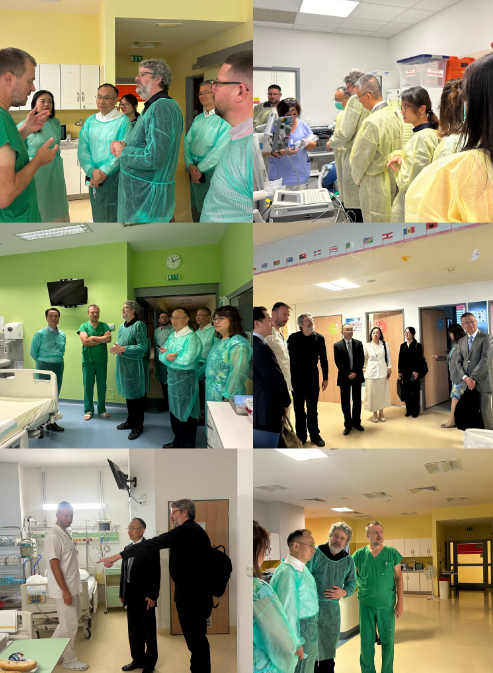
Czech Republic
Before World War II, the Czech Republic was one of Europe’s 10 most industrialized nations. As a former socialist country, its healthcare system is universal, with well-developed infrastructure, state-of-the-art medical equipment, and exemplary diagnostic and management standards. The country is home to top-tier medical centers and research institutions, where cutting-edge medical practices are carried out using the latest in diagnostic techniques and medical technologies. According to the Consumer Health Index, the Czech Republic ranks 13th among 35 European countries.
Motol University Hospital
The delegation first visited Motol University Hospital in Prague. Established in 1971, Motol University Hospital is a modern European clinical hospital and a leading research institution. It also serves as the second affiliated hospital of Charles University, providing comprehensive healthcare services to the residents of Prague and the entire Czech Republic. The hospital is renowned for serving VIP patients, including the President of the Czech Republic. It has a total of 2,300 beds, including 690 for pediatric care and 1,230 for adult care.
The delegation toured the hospital’s emergency and critical care areas for both adults and children, as well as the ICU in the Department of Anesthesiology, the Trauma and Orthopedic Center, and the Sports Medicine Surgery Unit. They were impressed by the hospital’s design, which reflects a strong sense of European cultural tradition and artistic heritage, as well as its highly efficient, patient-centered medical service processes. Discussions with the hospital’s management and clinicians covered topics such as the evaluation of healthcare workers, clinical and research goals, performance-based income distribution, and both external drivers and internal motivations for hospital development within the context of a public healthcare system in Eastern European welfare states.

The delegation also met with Professor Vladimir Cerny, a leading figure in the Czech healthcare system. Professor Cerny serves as the Chairman of the Czech Society of Anesthesiology and Intensive Care, is a lifelong professor at Charles University, and holds multiple academic committee memberships in the Czech Ministry of Health. President Zheng Xingdong from Shanghai General Hospital and Professor Cerny exchanged insights on the clinical and research innovations undertaken by both institutions in recent years. They also agreed to promote further personnel exchanges and collaborations in clinical and research fields, aiming to contribute to the development of China-Czech medical cooperation.
VAMED Medical Group
As a post-communist transition country with universal healthcare coverage, the Czech Republic’s national healthcare program is recognized as one of the best in the European Union, achieving a balance between the goals of “equity” and “efficiency” within its medical services system. In this, private healthcare institutions have played a significant role during the country’s transformation and health insurance reforms since the 1990s. The delegation visited the renowned Czech private healthcare group, VAMED MEDITERRA, and held discussions with its board members. VAMED provides specialized infrastructure and operational services to hospitals and healthcare institutions in over 100 countries worldwide. In the Czech Republic, its subsidiary, VAMED MEDITERRA, operates seven hospitals and one nursing school. Martin Tucek, a board member responsible for biomedical and digital transformation, provided the delegation with a detailed overview of the Czech healthcare system’s efforts and achievements in addressing global challenges, such as rapid population aging and limited healthcare resources. These efforts include advancements in AI-based medical imaging, VR rehabilitation, and the widespread use of electronic medical records. Martin also expressed a strong interest in collaborating with the Chinese medical community, which is at the forefront of artificial intelligence technologies.
As a former socialist country with universal healthcare, public medical institutions in the Czech Republic hold 80% of the market share, while private institutions provide 20% of medical services. Additionally, commercial health insurance is not permitted outside of the national health insurance plan. How do private healthcare institutions survive and thrive in a system where public hospitals dominate, universal coverage is in place, and a one-size-fits-all approach prevails? The delegation was intrigued by this question and discussed it with VAMED’s management. The answer lies in the high operational efficiency that distinguishes private hospitals from their public counterparts. VAMED also shared their extensive experience in cost-saving and profit-making strategies across various sectors, including human resources, energy, equipment, building management, and centralized procurement.
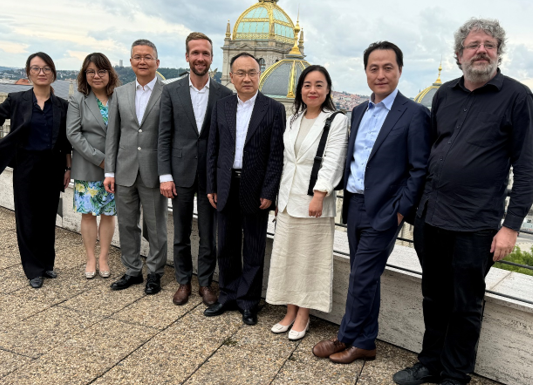
Broun Rehabilitation Hospital
As a key component of the national healthcare system, rehabilitation hospitals play a vital role in managing the treatment and care of patients during the recovery phase, which university hospitals focusing on medical care, education, and research often cannot address. The delegation’s visit to the renowned Broun Rehabilitation Hospital in the Czech Republic provided a comprehensive understanding of the country’s healthcare system.
Located 30 kilometers from the center of Prague, the Broun Rehabilitation Hospital sits at the foot of Karlstejn Castle, in a picturesque, lush, and serene environment. The hospital's Greek-born Director, Mr. Sotirios Zavalianis, along with his team, warmly welcomed the delegation. Mr. Zavalianis has devoted his life to the healthcare industry in the Czech Republic with passion and philanthropy. Known for his outstanding entrepreneurial spirit, he was named “Czech Entrepreneur of the Year” in 2023. As a self-made entrepreneur from a humble background, Sotirios feels a natural affinity for China. His presentation frequently highlighted his admiration for the Chinese work ethic, while also humorously acknowledging the “laid-back” culture that can sometimes be found under Europe’s high welfare system. Under his introduction, the true image of Broun Rehabilitation Hospital—renowned for being comprehensive, high-quality, modern, friendly, and trustworthy—was vividly and thoroughly presented to us.
The hospital consists of three interconnected buildings with an impressive and well-thought-out design. It boasts a modern Internal Medicine ICU ward, post-acute care, rehabilitation and arthroscopy centers, and a total of 150 early rehabilitation beds. The center is staffed with clinical psychologists, clinical speech therapists, and a high-quality prosthetics department. Rehabilitation services are provided for post-operative patients from orthopedic surgeries, such as total knee, hip, or shoulder joint replacements, as well as those recovering from major joint arthroscopy procedures. Services are also available for patients with traumatic injuries, degenerative spinal conditions, and neurological disorders like strokes and multiple sclerosis. The hospital collaborates with Charles University Hospital Prague to offer professional training for physical therapy students from six different faculties, receiving teaching certification from the Ministry of Health in this field. Sotirios guided the group through various rehabilitation areas, including music therapy, light therapy, hydrotherapy, art therapy, handicrafts, cooking therapy, sleep monitoring, and speech training. Equally impressive as the advanced facilities was the deep sense of human care and the home-like warmth that pervaded the center. President Zheng Xingdong warmly invited Sotirios to visit China to share his lifetime of experience in the rehabilitation hospital field with Chinese colleagues and draw inspiration from Eastern culture.
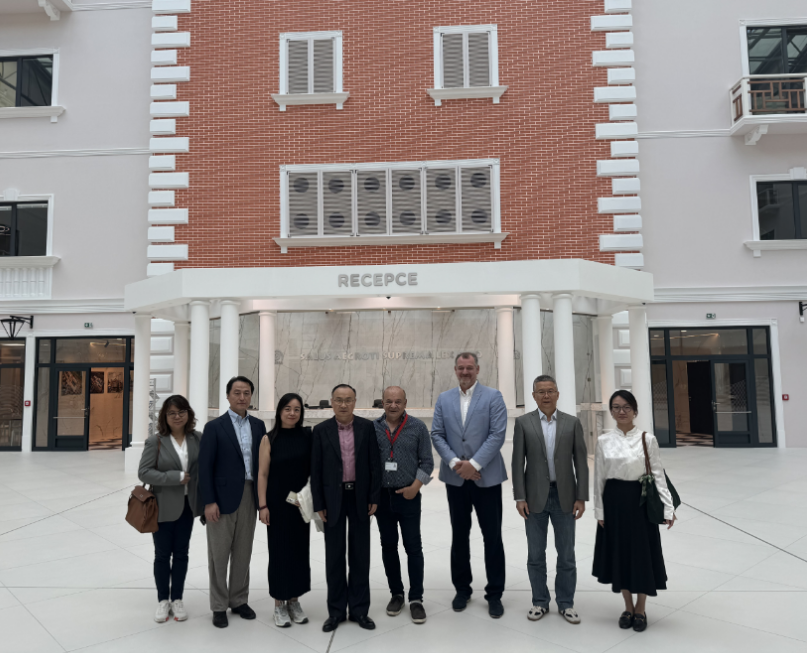
Hungary
After completing the exchange visit to the Czech Republic’s healthcare system, on the evening of September 10, the delegation traveled to the second stop of the tour: Hungary. Hungary, a country with a long history and outstanding achievements in the medical field, boasts a well-established healthcare system, comprehensive medical insurance, efficient management institutions, and high-quality medical services. The country leads in healthcare development in Central and Eastern Europe. Moreover, the Hungarian government places significant emphasis on the training and education of healthcare professionals, continually driving medical technology innovation and development at the national level.
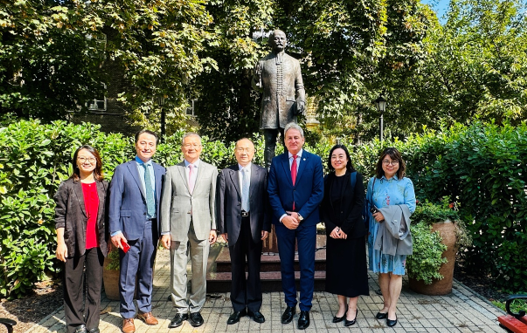
Visit Semmelweis University
The delegation first visited Semmelweis University, one of the most prestigious institutions in Budapest, the capital of Hungary. Established in 1769, Semmelweis University is Hungary’s oldest medical school. It was here that the Hungarian-German doctor Ignaz Semmelweis first advocated for strict hand hygiene measures, drastically reducing maternal mortality rates, marking a significant advancement in the history of Western medicine in overcoming infection. Named after this renowned physician, Semmelweis University became an independent university after World War II. With over 250 years of development, it has become a leading institution in medical higher education, healthcare provision, and research excellence in Hungary and Central Europe, ranked first in life sciences and medical training among Hungarian higher education institutions. Combining innovation with tradition, the university excels in education, research, and healthcare, with six faculties and a doctoral school covering all aspects of medical and health sciences education. It has cultivated numerous healthcare professionals and researchers, earning a strong international reputation, with one-third of its students coming from abroad. As a key partner for Chinese students pursuing medical training and scientific research in Europe, Semmelweis University plays a significant role in fostering international collaboration.
Led by Mr. Marcel Pop, Director of the International Office of Semmelweis University, the delegation was introduced to the university's rich history and ambitious present. The visit included a tour of the campus, showcasing a unique blend of historical and modern academic architecture, cultural environment, and interior design. The delegation also visited key centers at Semmelweis University Hospital, including the Translational Research Center, the Heart and Vascular Center, the Trauma Emergency and Sports Medicine Center, and the Pancreatic Disease Center, engaging in in-depth discussions.
The Translational Research Center was established and is led by Professor Peter Hegyi, a renowned pancreatic disease expert in Europe. Professor Hegyi is the Chair of the Clinical Science Department of the European Academy of Sciences and also heads the Innovation Translational Research Center and Pancreatic Disease Center at Semmelweis University. Under his leadership, these centers have achieved remarkable advancements in clinical, research, and translational innovation. During the visit, Professor Hegyi introduced the strategic vision and operational model of both the Translational Research Center and the Pancreatic Disease Center, which are supported by over 200 experts from Semmelweis University and the European Academy of Sciences, offering professional guidance to researchers worldwide. The center also boasts a team of 55 experts across data, statistics, experimentation, and incubation, providing comprehensive support throughout the entire research process. It offers training and project guidance for researchers at all levels, from high school students to PhD candidates, young doctors, and full-time researchers, helping them validate their research ideas, achieve scientific results, and enhance their scientific capabilities. The Pancreatic Disease Center follows a multidisciplinary management approach, emphasizing that all pancreatic cancer patients must be included in a comprehensive treatment system, where multidisciplinary team meetings determine treatment plans, and patients are managed through a system that integrates clinical research.
Deeply familiar with Chinese culture, Professor Hegyi expressed strong interest in fostering research and clinical collaboration with Shanghai Jiao Tong University School of Medicine and Shanghai General Hospital. He proposed a specific cooperation model: joint mentorship teams composed of Chinese and Hungarian professors, where young doctors or researchers can join the Translational Research Center with a project and receive comprehensive support from experimental design, quality control, clinical integration, operational management, data collection, statistical analysis, academic writing, and result translation.
Quoting the famous Chinese saying by Confucius, "A journey of a thousand miles begins with a single step," Professor Hegyi also referenced Chinese President Xi Jinping's recent visit to Hungary in May, noting that this is the best period in the 75 years of Sino-Hungarian diplomatic relations, and that we should seize this historic opportunity to advance significant progress in medical cooperation between the two countries. President Zheng Xingdong of Shanghai General Hospital emphasized that, as a Chinese research hospital with a long history and a strong foundation currently undergoing rapid development, Shanghai General Hospital looks forward to collaborating with Semmelweis University in clinical, research, and talent exchange. He invited Semmelweis University’s experts and students to visit Shanghai soon for exchanges and collaboration across various fields.
The delegation also visited Semmelweis University Hospital’s Heart and Vascular Center and the Trauma Emergency Center, where they explored the hospital’s clinical treatment, technology, staffing, management models, and research development in these areas. They were introduced to the hospital's highly efficient multidisciplinary collaboration model for treating a wide range of diseases.
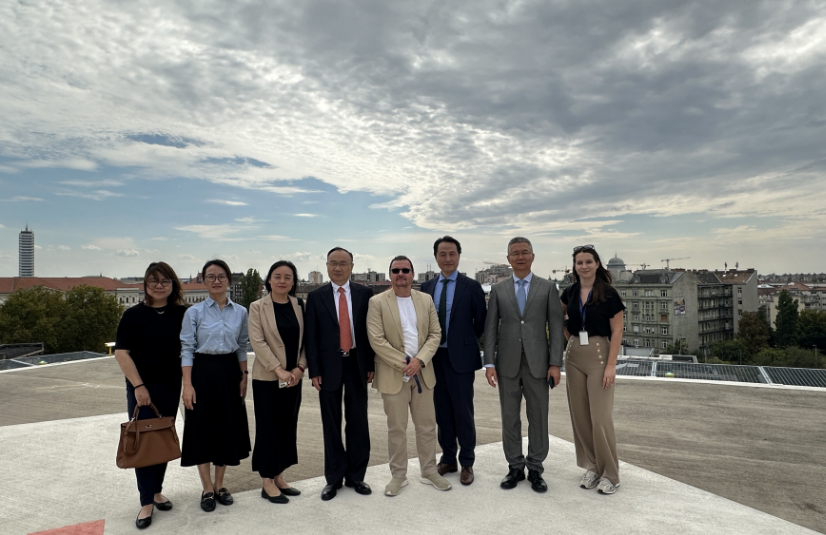
Gottsegen National Cardiovascular Center (GOKVI)
The delegation also included Dr. Liu Shaowen, Director of Shanghai General Hospital's Heart and Major Vascular Center. In addition to visiting Semmelweis University’s Heart and Vascular Center, the delegation visited the Gottsegen National Cardiovascular Center, a top public hospital and research center in Hungary, specializing in cardiovascular medicine and integrating healthcare, education, research, health promotion, talent development, and international cooperation.
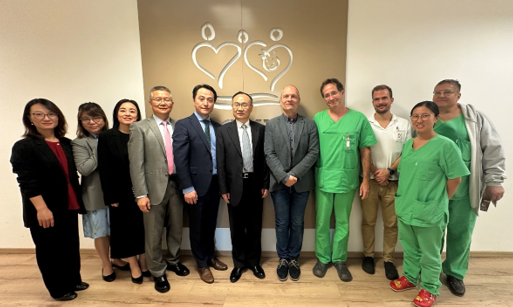
Prof. Dr. Peter Andreka, Director of GOKVI, and his team warmly welcomed the delegation, providing a comprehensive introduction to the history, current status, and future strategies of GOKVI. Established in 1957, GOKVI is Hungary’s leading institution for the diagnosis and treatment of cardiovascular diseases, serving an average of 9,000 inpatients and 90,500 outpatients annually. The center currently operates with 275 beds and 28 specialized outpatient clinics. Its technological capabilities include a full spectrum of reliable cardiovascular diagnostics and non-invasive and invasive treatments for both pediatric and adult cardiovascular conditions, including interventional cardiology, electrophysiology, cardiac surgery, heart transplantation, and vascular interventions.
GOKVI is also Hungary's only research center capable of treating all types of cardiovascular diseases and serves as the national registry for myocardial infarction, heart failure, vascular procedures, cardiac surgery, coronary interventions, PM/ICD, and congenital heart disease. All hospitals in Hungary that treat cardiac patients are required to connect to this database, providing a robust data source for cardiac-related research. In addition, GOKVI plays a key role in training professionals in cardiovascular medicine, serving as a practical and internship hospital for Semmelweis University, the University of Pécs, and the University of Debrecen. Each year, the hospital trains a large number of undergraduate interns, graduate students, resident doctors, and Ph.D. candidates, contributing significantly to Hungary’s medical workforce. Since its founding, GOKVI has performed 56 congenital heart disease transplants, 48,635 adult heart surgeries, 11,100 pediatric heart surgeries, 27,852 coronary angioplasties, and 147,889 catheterization procedures, including 17,084 pediatric catheterizations, among other operations.
The delegation held in-depth discussions with Prof. Dr. Andreka and his team on topics such as societal screening and prevention of cardiovascular diseases, clinical research system design, the establishment of disease-specific databases for cardiovascular conditions, and experiences, challenges, and prospects in conducting clinical research.
President Zheng Xingdong extended an invitation to Director Andreka and his team of experts to visit and collaborate with Shanghai General Hospital, encouraging both sides to strengthen cooperation in clinical techniques, scientific research innovation, and chronic disease management. Through a spirit of sharing, cooperation, and mutual benefit, the two sides aim to advance medical progress in the cardiovascular field between China and Hungary.
The week-long visit to the Czech Republic and Hungary, led by President Zheng Xingdong, featured a tight schedule, rich content, and focused discussions. It helped to establish mutual trust and friendship with each of the visited institutions, creating opportunities for Shanghai General Hospital to further expand medical cooperation and exchanges with countries along the Belt and Road. This visit also provided valuable insights into enhancing the hospital’s international perspective as Shanghai’s International Medical Tourism Pilot Hospital. It encouraged further integration with international practices and opened avenues for medical professionals from Belt and Road countries to engage with Shanghai General Hospital, as well as for patients from these regions to seek treatment at the hospital.
Taking this visit as an opportunity, Shanghai General Hospital plans to deepen international medical cooperation with Central and Eastern European countries, including Hungary and the Czech Republic. The hospital aims to exchange knowledge on the similarities and differences in the healthcare industry under different systems, learn from each other’s advanced hospital management models, hospital construction, discipline development planning, and the transformation of scientific research innovations. Through this, Shanghai General Hospital seeks to gather insights and inspiration for its own high-quality development as a leading public hospital in China, with a future-oriented and global outlook.
(Compiled by Liu Fang)
